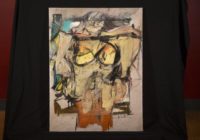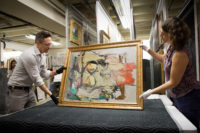 In a happy counterpoint to yesterday’s sad news, a painting by Willem de Kooning stolen from the University of Arizona Museum of Art in Tucson 32 years ago has been found and returned to the museum. Woman-Ochre was snatched November 29th, 1985, the day after Thanksgiving, in a classic two-person misdirection ploy. A woman and a man waltzed into the museum bright and early at 9:00AM. The woman ran interference with the security guard, capturing his attention while her partner cut the painting out of the frame. They quickly left together and that was the last anyone saw of them. The whole operation from entry to exit had taken less than 15 minutes.
In a happy counterpoint to yesterday’s sad news, a painting by Willem de Kooning stolen from the University of Arizona Museum of Art in Tucson 32 years ago has been found and returned to the museum. Woman-Ochre was snatched November 29th, 1985, the day after Thanksgiving, in a classic two-person misdirection ploy. A woman and a man waltzed into the museum bright and early at 9:00AM. The woman ran interference with the security guard, capturing his attention while her partner cut the painting out of the frame. They quickly left together and that was the last anyone saw of them. The whole operation from entry to exit had taken less than 15 minutes.
The subsequent police investigation failed to find the culprits or the painting and for three decades the case was cold as ice. It turned burning hot earlier this month when David Van Auker, Buck Burns and Rick Johnson, owners of Manzanita Ridge Furniture & Antiques in Silver City, New Mexico, bought the painting at an estate sale. Van Auker saw it hanging behind the bedroom door at the home of Jerry and Rita Alter in Cliff, New Mexico, and decided to buy it along with a pile of other assorted gewgaws from the sale. He had no idea it was an original de Kooning; he just thought it was cool.
He propped the painting up against the wall of his shop and a customer told him it looked like a de Kooning. Then another customer noticed it and mentioned it could be a de Kooning oil painting. A third soon joined the chorus. Van Auker started getting antsy. Much Googling ensued, and when he read about the theft from the museum, he realized he very likely had a gazillion dollar stolen painting in his shop. He nervously moved it into the bathroom to keep it out of view of any more customers.
Van Auker called the UAMA and told them he thought he had their long-lost de Kooning. The next day the head of the museum, a curator and a restorer from the Arizona State Museum scrutinized the painting. The restorer examined it for two hours at the end of which she confirmed that it was authentic. After spending a night under lock and key at the local police station, Woman-Ochre was transported back to the museum in Tucson.
“This is a monumental moment for the museum,” said Meg Hagyard, director of UAMA. “We are thrilled at the possibility that this work could once again be on exhibit in our galleries. This is an especially poignant moment, as ‘Woman-Ochre’ was donated by Edward Joseph Gallagher Jr. as part of one of the largest gifts in the museum’s history. Having both the collection and that gift complete once again is something that we’ve always hoped for.
 Woman-Ochre is one of a series of paintings de Kooning did exploring the female form, a subject that many critics and artists asserted had been superseded by abstract, non-representational art. While eschewing the traditional depictions of what he called “the idol, the Venus, the nude,” Kooning drew from a wide range of iconographic references — prehistoric mother goddess figurines, advertising models, pinup girls — to create abstract expressionist versions of figures out of thick lines and dynamic slashes of color.
Woman-Ochre is one of a series of paintings de Kooning did exploring the female form, a subject that many critics and artists asserted had been superseded by abstract, non-representational art. While eschewing the traditional depictions of what he called “the idol, the Venus, the nude,” Kooning drew from a wide range of iconographic references — prehistoric mother goddess figurines, advertising models, pinup girls — to create abstract expressionist versions of figures out of thick lines and dynamic slashes of color.
Paintings in de Kooning’s Woman series today grace the walls of the world’s top museums, and on the rare occasions when they become available on the market, they sell for astronomical prices. Ten years ago one sold for $137.5 million. Bound by the terms of the Gallagher donation, the UAMA cannot sell the painting even if it wanted to, which it most emphatically does not, but based on the comparables, it could be worth something in the neighborhood of $160 million.
At the time of the theft, the painting was insured for $400,000, a risibly small sum compared to its market value today. The museum very wisely put the money in an endowment fund and used the interest to upgrade its security systems. Upon the painting’s return, the museum paid back the original $400,000 to the insurers so they again have clean title to the artwork.
The de Kooning is in need of some tender loving care. The edges are ripped from being hacked out of the original frame and whatever jackass reframed it stapled it to a board. The thieves also rolled it up for ease of transport, making the paint brittle in parts. Thankfully it has not begun to flake yet. Before the painting goes back on display, it will undergo thorough restoration and study. Meanwhile, the FBI is investigating how the stolen work wound up in the nice but humble three-bedroom home of a retired music teacher and a retired speech pathologist.